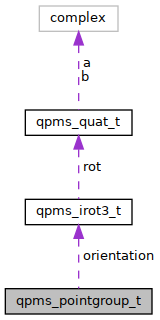 |
QPMS
Electromagnetic multiple scattering library and toolkit.
|
 |
QPMS
Electromagnetic multiple scattering library and toolkit.
|
Full characterisation of a 3D point group. More...
#include <qpms_types.h>

Data Fields | |
| qpms_pointgroup_class | c |
| Point group classification. | |
| qpms_gmi_t | n |
| qpms_irot3_t | orientation |
| Transformation between this point group and the "canonical" point group of the same type. More... | |
Full characterisation of a 3D point group.
| qpms_gmi_t qpms_pointgroup_t::n |
Order of the rotational subgroup \( \mathrm{C_n} \) of finite axial groups.
| qpms_irot3_t qpms_pointgroup_t::orientation |
Transformation between this point group and the "canonical" point group of the same type.
Each 3D point group of a given type (specified by the c and n members) has its isomorphous "canonical instance", typically with the main rotation axis identical to the z cartesian axis and a mirror plane (if applicable) orthogonal to the x cartesian axis.
If \( o \) is a transformation specified by orientation, then an element \( g \) of this group can be written as
\[ g = o g_\mathrm{can.} o^{-1} \]
where \( g_\mathrm{can.} \) is a corresponding element from the canonical instance.
CHECKME \( o \) transforms the cartesian z axis to the main rotation axis of this group (if applicable).
TODO more detailed specification about the canonical instances and in which direction orientation goes.